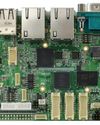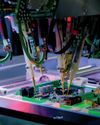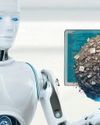يحاول ذهب - حر
Build an Interactive Kinetic Wall
October 2024
|Circuit Cellar
Using a Raspberry Pi 4 and Kinect V1 Camera

Arijit describes an interactive kinetic wall built by his team that pushes the boundaries of traditional art and engineering and creates a dynamic and immersive experience. Through its responsive movements and visual effects, it engages viewers and invites them to shape the artwork. Powered by the Raspberry Pi 4, the kinetic wall was designed to capture the modern spirit, when art, science, and technology converge and re-invent the perception of beauty and interactivity.
The genesis of our project is an interactive kinetic wall powered by Raspberry Pi shown in Figure 1. It stems from a unique collaboration of my company with an entertainment company seeking an innovative and captivating way to engage and attract audiences to their events.
We explored a variety of possibilities after being given this fascinating task, but we ultimately settled on the idea of an interactive kinetic wall, because of its unique qualities and tremendous interaction potential.
The kinetic art movement of the 20th century served as the inspiration for the idea of kinetic walls, which has a rich historical background. Artworks that moved, altered shape, and responded to outside stimuli were first made possible by kinetic artists like Alexander Calder and Jean Tinguely. A new wave of innovation was inspired by this movement, which signaled a radical departure from conventional static art forms and promoted a dynamic interaction between art and technology.
This project embodies the fusion of art, technology, and entertainment, representing a contemporary interpretation of the historical kinetic art movement.
 BASIC PROTOTYPING
BASIC PROTOTYPING هذه القصة من طبعة October 2024 من Circuit Cellar.
اشترك في Magzter GOLD للوصول إلى آلاف القصص المتميزة المنسقة، وأكثر من 9000 مجلة وصحيفة.
هل أنت مشترك بالفعل؟ تسجيل الدخول
المزيد من القصص من Circuit Cellar
Circuit Cellar
Alif Semiconductor Elevates Generative AI at the Edge with New Support for ExecuTorch Runtime in Its Ensemble MCUs
Alif Semiconductor, the leading global supplier of secure, connected, power efficient Artificial Intelligence and Machine Learning (AI/ML) microcontrollers (MCUs) and fusion processors, announced that developers can now use the ExecuTorch Runtime, a quantization extension of the popular PyTorch ML framework, for AI applications built to run on its Ensemble E4/E6/E8 series of MCUs and fusion processors.
1 min
December 2025

Circuit Cellar
Encrypted MQTT Protocol for Critical Sectors
Mechanisms, Challenges, and Best Practices
3 mins
December 2025

Circuit Cellar
Datasheet: Small Size, Big Power
Smaller Microcontrollers Bring New Possibilities
9 mins
December 2025

Circuit Cellar
Analog Devices Launches ADI Power Studio and New Web-Based Tools
Analog Devices, Inc. (ADI), a global semiconductor leader, announced the launch of ADI Power Studio, a comprehensive family of products that offers advanced modeling, component recommendations, and efficiency analysis with simulation.
1 mins
December 2025

Circuit Cellar
Compact IBR300 2.5" SBC Powered by NXP i.MX 93 from IBASE
IBASE Technology, Inc., a leading provider of rugged embedded computing platforms, announced the release of the IBR300, a 2.5\" RISC-based single board computer (SBC) powered by the NXP i.MX 93 processor with dualcore ARM Cortex-A55 (up to 1.7GHz) and a Cortex-M33 MCU.
1 min
December 2025

Circuit Cellar
Sensors in the Spotlight
The Next Decade of Embedded Sensor Systems
12 mins
December 2025

Circuit Cellar
Bob's Wrap Up
In Bob's last article with Circuit Cellar, he attempts to wrap up a career of more than 50 years as an embedded systems engineer and 14 years with Circuit Cellar. He looks at each of his 58 articles by category and provides some recommendations for his fellow engineers.
7 mins
December 2025

Circuit Cellar
Designing Embedded Software Architectures That Last
I've reviewed hundreds of firmware projects over the years, and one thing always stands out: the most successful projects have a clear, deliberate architecture.
10 mins
December 2025
Circuit Cellar
Broadcom Introduces Industry's First Wi-Fi 8 Silicon Ecosystem Powering the AI Era
Broadcom, Inc. unveiled the first Wi-Fi 8 silicon solutions for broadband wireless, targeting residential gateways, enterprise access points, and smart mobile clients.
1 mins
December 2025

Circuit Cellar
GD32 MCU Family Expands High-Performance Portfolio with New GD32F503/505 Series MCU
GigaDevice, a leading semiconductor company specializing in Flash memory, 32-bit microcontrollers (MCUs), sensors, and analog products, announced the official launch of the GD32F503/505 series of high-performance 32-bit MCUs, expanding its product range based on the ARM Cortex-M33 core.
1 mins
December 2025
Listen
Translate
Change font size

